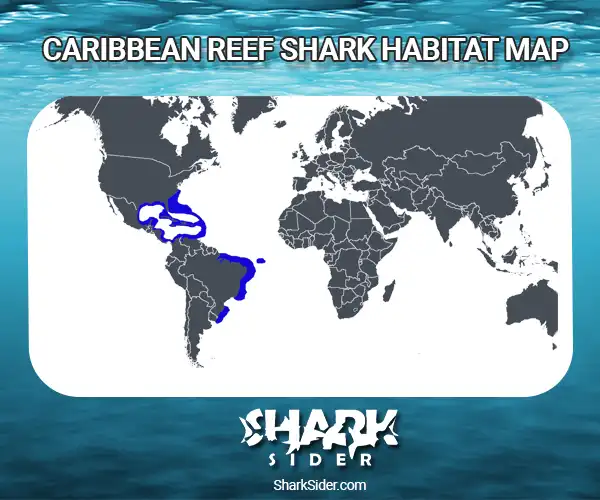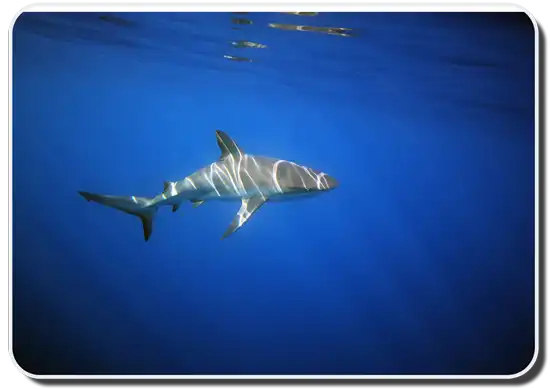The Caribbean Reef Shark, also called the Carcharhinus Perezi in the scientific community, is a member of the requiem shark species. They are mostly found on the East coast of America (Atlantic coast) and southwards. The structure of this shark is streamlined and robust and can be easily confused with other sharks in its family. When you look up close, they have an extra rear tip on the second dorsal fin. The first dorsal fin is slightly angled or curved and the gills slits are also longer than most other varieties of sharks.

Dubbed “the silent sea predator”, they can grow up to 10 meters long (3+ feet) and can weigh up to 70kg or 154lbs. That’s one big fish! While it is considered dangerous to humans, this shark does not have a history of attacks on humans.
Also known as the “Reef Shark”, it has a unique color and is white to light yellow on the ventral side and grey-brown to dark-grey on the dorsal side. It has larger eyes and the snout is rounded and short in comparison to other sharks.
This shark breed is actively fished as a source of meat and liver oil. In addition, they also attract attention from eco tourists in the Bahamas. The Bahamas are known to host questionable shark feeding programs to attract visitors and the Caribbean Reef Shark is one of the major attractions.
Although laws ban the hunting or fishing of this species, the fishing industry in South America still finds these sharks in about 40% of their fish catch. While the catches are unintended, there has still been a drastic impact on the population and the population continues to dwindle.
Habitat
These sharks prefer the shoreline from Florida to Brazil. This is where it gets the common name from. The tropical parts of the western Atlantic Ocean is home to this variety of sharks. Normally found on the outer edges of reefs, the Caribbean Reef Shark prefers to live in coral reefs and its shallow waters as well as continental shelves and insular shelves. These sharks are found quite commonly at a depth of about 100 feet (30 meters) and are known to dive to incredible depths of around 1250 feet (380 meters).
The Caribbean Reef Shark also finds its food in the reefs such as bony fishes, large crustaceans and cephalopods. This shark is also known to feed on yellow sting-rays and eagle rays quite frequently. A unique feature of these predators is that they are capable of reverting or purging their own stomachs. This helps purge the parasites, mucus or any other objects on the stomach lining.

Social Behavior
The Caribbean Reef Shark is known to be relatively passive and typically doesn’t pose much of a threat to scuba divers, snorklers, swimmers, or other humans it comes into contact with. They actually tend to avoid human interaction entirely. As per the International Shark Attack Files, there have been 27 attacks documented since 1960, of which none have been fatal. Of those attacks, it’s believe that 4 of them were caused because the shark mistakenly thought the person was a food source. The rest of the attacks were provoked attacks such as sharks caught in fishing equipment biting the fisherman.
Socially, they are mostly loners unless living in a threatening ecosystem. These are the first and the only species of sharks that are known to “sleep” on the ocean floor or within reef caves. It is believed that these sharks are not actually sleeping but merely resting. These sharks have actually been given the nickname “sleeping sharks” because of their habit of lying motionless at the sea bottom. This is a somewhat unusual and unique behavior of these sharks.
The Caribbean Reef Shark is known to become aggressive in the presence of food, but they are mostly only considered dangerous to humans because of its size. This shark was fished in Belize for almost the entire 20th century. They were used to make local delicacies in addition to liver oil (mostly used in cosmetics). Their low reproduction rate combined with a high level of hunting and fishing have caused the numbers to dwindle. The shark is now considered to be near threatened. Many countries and organizations have banned the commercial fishing of this species.
When threatened, the Caribbean Reef Shark is known to do a “threat dance” that includes swimming in zig-zag motion while dipping the pectoral fins at intervals of 1-2 seconds. When divers see this, they know it is best to get away as quickly as possible.

Offspring
Adults begin to reproduce once they attain a size of 2 to 3 meters (female) or 1.5 to 1.7 meters (male). They reproduce once per year but childbirth is biennial since the females get pregnant every other year. The reproduction method is Viviparous which means the pups develop inside of the mother. There is evidence that the reproduction method is aggressive and violent since many female Caribbean Reef Sharks have been found with deep wounds on their sides during mating season. These wounds are caused by bites and heal in time leaving large and highly visible scars.
Females are known to migrate to nursery water before giving birth and these waters lie to the northwest of the Brazilian coast. Actual birth occurs at different times but is usually either between February and April or November to December.
Once the female shark is pregnant, it takes about one year to give birth. The litter size is normally between four to six pups. The newborn pups are about 0.5 – 0.7 meters (1.6 – 2.3 feet) in size. The younger Caribbean Reef Sharks prefer living in shallow waters until they grow bigger and fend for themselves.
Caribbean Reef Shark Facts
1. No other shark is as attracted to feeding dives
The Caribbean Reef Shark is the one species that is the most easily attracted to feeding attempts. Diving companies easily drive schools of these great, 10-foot predators by scattering bait around. Other species are rarely as quickly interested.
While these sharks are decidedly dangerous predators, they don’t tend to attack humans. Marine biologists have observed that this particular shark species tends to ignore humans, simply seeing them as deliverers of food in feeding dives, rather than food themselves. According to the International Shark Attack File, only four unprovoked attacks have so far been recorded worldwide. One such attack was recent attack was recorded by the diver who went through it (see: dailymail.co.uk/travel/article-2583303/Video-shows-terrifying-moment-diver-Jason-Dimitri-fends-underwater-Caribbean-shark-attack.html).
2. You can learn to identify a Caribbean Reef Shark
With its gray-white coloring and the classic streamlined form associated with large sharks, the majestic Caribbean Reef Shark isn’t easy to tell apart from the Sandbar Shark, the Silky Shark or other large species local to the region. There are ways to identify them, though, if you know how.
When you approach a Caribbean Reef Shark, you’ll see whitish bands around the flanks. These are the most readily recognizable feature of the species. If you are in well-lit conditions, you should be able to see dark-colored margins to the caudal fin, and a prominent ridge close to it. It is sometimes easy to get healthy, full-grown Caribbean Reef Sharks mixed with Bull Sharks. The two species, while superficially similar, are different in an important way — Bulls have shorter noses and wider dorsal fins.
3. Caribbean Reef Sharks have long been thought to enjoy “sleeping”
Caribbean Reef Sharks first became well-known around the world when National Geographic investigated a peculiar behavior observed in the species – sleeping. These sharks would descend to caves at the bottom of the sea, and float motionless for hours at a time. While some lethargic shark species have for long been known to remain still or to “sleep” in this way, the National Geographic story was the first time that people saw that active, aggressive sharks could do the same. They were called the Sleeping Sharks of Isla Mujeres, the area off the Yucatan where the sharks were studied.
As scientists continued to study the behavior, they came to the conclusion that the sharks didn’t actually sleep; it was behavior that was even more humanlike – they were on a narcotic high (see: elasmo-research.org/education/topics/b_40_winks.htm). In certain areas, cold water upwellings tended to free these sharks of some parasites, an action that caused them to feel a high. Unfortunately, this particular action isn’t seen in Caribbean Reef Sharks in any other part of the Caribbean.

4. These sharks have attitude
With most aggressive shark species, it’s easy to tell when they are about to strike – they move quickly and directly towards their prey, with obviously belligerent intent. Being highly intelligent, the Caribbean Reef Shark tends to dissemble.
When it aims for a particular fish, human or other prey, it tends to move towards it in a languid manner, gently wheeling and spiraling in its general direction, without obviously aiming for it. Once it gets reasonably close, it briefly accelerate past its prey before making a lightning-fast turn just when the prey believes that it isn’t the object of the pursuit. Scientists tend to liken the hunting style of the Caribbean Reef Shark to the technique adopted by a practiced boxer attempting to get an opponent to drop his guard before moving in for the kill.
5. They are sophisticated enough to have a trademark dance
When the average shark feels threatened, it either directly attacks or beats a retreat. The Caribbean Reef Shark does nothing as predictable. It launches into an elaborate threat dance routine – it zigzags around and dips its pectoral fins as if flexing them. The overall appearance is one of a recognizably rhythmic dance. Anyone who recognizes it needs to clear out as soon as possible.
6. Caribbean Reef Sharks are their own ecosystem
Caribbean Reef Sharks are large, terrifying predators that can eat practically anything in the sea. Yet, anywhere they go, they travel with a little posse of small fish swimming along close to their mouths. The sharks never snap them up.
These fish are part of the shark’s food-seeking system. They are able to sense the presence of food in some ways that the sharks cannot, and are able to lead the large predators to it. In return, the little fish get the scraps.
These sharks have other relationships with small fish for other purposes. The goby, the surgeonfish, the wrass and other small cleaner fishes set up base around an area, and signal their ability to offer cleaning services. Sharks swim up, communicate their willingness to be cleaned, and let the fish do their job. The cleaner fish eat what they find, and the sharks go away clean. It’s the perfect business relationship.
